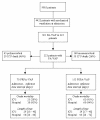Impact of ureido/carboxypenicillin resistance on the prognosis of ventilator-associated pneumonia due to Pseudomonas aeruginosa
- PMID: 21481266
- PMCID: PMC3219393
- DOI: 10.1186/cc10136
Impact of ureido/carboxypenicillin resistance on the prognosis of ventilator-associated pneumonia due to Pseudomonas aeruginosa
Abstract
Introduction: Although Pseudomonas aeruginosa is a leading pathogen responsible for ventilator-associated pneumonia (VAP), the excess in mortality associated with multi-resistance in patients with P. aeruginosa VAP (PA-VAP), taking into account confounders such as treatment adequacy and prior length of stay in the ICU, has not yet been adequately estimated.
Methods: A total of 223 episodes of PA-VAP recorded into the Outcomerea database were evaluated. Patients with ureido/carboxy-resistant P. aeruginosa (PRPA) were compared with those with ureido/carboxy-sensitive P. aeruginosa (PSPA) after matching on duration of ICU stay at VAP onset and adjustment for confounders.
Results: Factors associated with onset of PRPA-VAP were as follows: admission to the ICU with septic shock, broad-spectrum antimicrobials at admission, prior use of ureido/carboxypenicillin, and colonization with PRPA before infection. Adequate antimicrobial therapy was more often delayed in the PRPA group. The crude ICU mortality rate and the hospital mortality rate were not different between the PRPA and the PSPA groups. In multivariate analysis, after controlling for time in the ICU before VAP diagnosis, neither ICU death (odds ratio (OR) = 0.73; 95% confidence interval (CI): 0.32 to 1.69; P = 0.46) nor hospital death (OR = 0.87; 95% CI: 0.38 to 1.99; P = 0.74) were increased in the presence of PRPA infection. This result remained unchanged in the subgroup of 87 patients who received adequate antimicrobial treatment on the day of VAP diagnosis.
Conclusions: After adjustment, and despite the more frequent delay in the initiation of an adequate antimicrobial therapy in these patients, resistance to ureido/carboxypenicillin was not associated with ICU or hospital death in patients with PA-VAP.
Figures


References
-
- NNIS. National Nosocomial Infections Surveillance (NNIS) System Report, data summary from January 1992 through June 2004, issued October 2004. Am J Infect Control. 2004;32:470–485. - PubMed
-
- Chastre J, Fagon JY. Ventilator-associated pneumonia. Am J Respir Crit Care Med. 2002;165:867–903. - PubMed
-
- REA-RAISIN Annual report 2009. http://www.cclinparisnord.org/REACAT/REA2009/rea_raisin_resultats2009.pdf
-
- Singh G, Wu B, Baek MS, Camargo A, Nguyen A, Slusher NA, Srinivasan R, Wiener-Kronish JP, Lynch SV. Secretion of Pseudomonas aeruginosa type III cytotoxins is dependent on pseudomonas quinolone signal concentration. Microb Pathog. 2010;49:196–203. doi: 10.1016/j.micpath.2010.05.013. - DOI - PMC - PubMed
Publication types
MeSH terms
Substances
LinkOut - more resources
Full Text Sources
Medical

